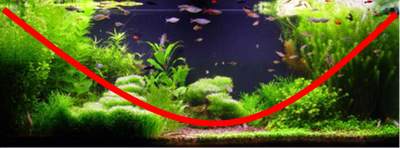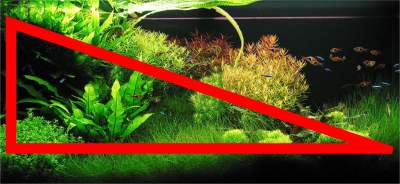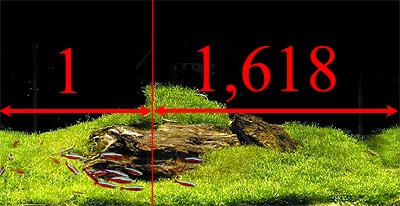|

Aquascaping Principles
|
First in a series of Aquascaping articles
Aquascaping 101
This is the article that my friend Birgit Fruehwirth who lives in Austria wrote for a forum a
while back that will stand the test of time. Birgit has gracefully given permission to publish this article for all of you who would like to try your hand at aquascaping. Next week I will go into some particulars for aquascaping, considerations for placement of individual species, compatabilities, color textures. Until then, enjoy Birgits article!
Don Matakis
Aquascaping
In recent years the
term aquascaping has become better known by aquarists
all over the world. The big man from Japan, Takashi
Amano started with his books, a new style in aquaristic.
The simple gathering of plants, beautiful stones and
driftwood is no longer the goal of many
aquarists.
Aquascaping has become a valued
art.
This article is based on the style and ideas
of the Nature Aquarium, combined with my very own
opinions and experiences. It is allways a question of
personal preferences on what type of aquascape you try
to achieve. Many people just love those good looking
japanese aquascapes, but they donīt feel able to achieve
it. It is not a question of experience wether you can do
it or not. It is no more difficult to have a beautiful
Nature Aquarium than it is to have a normal tank. It is
just the careful selection of plants and accessories
that makes the difference. So many people just donīt
have enough self confidence to try it. This article will
give you a very compact guideline. Follow the rules and
you will achieve your goal.
Amanos Nature
Aquarium (NA) is often misunderstood. It is not the aim
of the NA to reproduce nature biotopes of special
regions. It is more the goal of creating an underwater
landscape. A landscape seen before in real nature, not
under water.
I myself started, trying to copy some of
Amano's works. But soon I realised that you cannot copy
anything that has to do with living beings. Nevertheless
it is good for practicing to start with copying an
aquascape you really like. You will automatically use
the right plants, place the stones correctly and create
some free space which will give your tank more depth of
field. With time, you will develop your own style, and
sometimes you will like it even more than the one you
tried to copy.
Then you start your new setups by
thinking of a landscape you once saw and really liked.
This may be just an accumulation of stones in the
mountains, or a huge clearance in a wood. Everyone has
his own preferrals, so everyone will choose another
landscape and get his own style.
In Nature Aquarium,
plants AND fishes are the centerpiece of a tank. In
providing the best conditions for your plants to grow,
you usually do the same for your fishes. When the plants
have everything they need to grow well, at the same time
they provide the best conditions for your fishes. Plants
use up excessive nutrients in the water that may cause
Nitrate levels to spike, and they produce oxygen which
is indespensable to the life of fishes.
AGAIN:
This short article shall help you create those beautiful
aquascapes you have seen in books or on the net and you
never thought you can achieve.
So letīs
start:
1. Imagination
Imagination is
the key to aquascaping.
Get the pictures of
available plants and accessories into your mind. Try to
combine them in several ways. If you are not able to do
this, youīd better start with copying a tank you like.
With time you will find it easier to do your imaginative
work.
Youīve got your picture? Well, then letīs
go.
2. Choosing a background
There are
some different ways of choosing a background. Some
people use cork, others wood, some paint the background
and some use self adhesive foliage. No matter what you
do: as long as you donīt want your tank to stand in the
middle of a room, give it a background. It is very
unnatural to see the wall with all the hoses and cables
shining through the tank.
When painting, or using
foliage: Youīd best use black or blue. This will give
your tank a wonderful contrast and also make it easy to
concentrate on the tank itself. You donīt want the
people to focus on the background, just because it is
red?
3. Choosing your substrate
It is
unlikely that your aquascape will look natural when you
use pink, blue or bright green gravel. Youīd better choose
brown, gray or black. There are many different types of
substrate that will assist your plants in growth.
4. Choosing the shape of your
future layout
There are several composition
types:
The concave setup (high on either side and low
in the middle)

The convex setup (the opposite of the one above, so
low on either side and high in the middle)

"Convexity" doesnīt need to be produced by
plants only, as you can see.
The triangular
setup (high on one side, getting lower to the
other)

The rectangular setup (high everywhere). This is the
one you should avoid. It doesnīt give you areas of free
space. But these are very important to create an
illusion of depth. So less sometimes is much
more.
5. Choosing the accessories
For a
long time, aquarists where looking for the perfect
(beautiful) piece of driftwood, or stone. Then they
placed it into the tank, and.... well, it didnīt look
satisfying, did it?
Especially when making a setup
with stones it is much more important to use different
sizes of the same type, than just take one very
beautiful stone. One single stone in a tank will allways
look artificial, but when you place two or more, thatīs
what you usually see in nature. OK, OK there is Ayers
Rock, but it doesnīt actually look natural, does it
(sorry to the Australians, didnīt mean to offend
you).
Now take your stones or your driftwood and
place them in a triangle (if they are at least three).
The biggest one (if really big enough) usually is the
main focal point, so take special care where to place it
(see golden ratio in main focal points in the following
chapter).
Never use different type of stones or
driftwood. You can gather the ugliest stones you can
think of. They just have to be the same type. Place them
correctly in a group: I promise, they will look nice
(donīt know if it works for red-bricks
though)!
6. Setting the main focal
points
To get a smooth aquascape you need to set
one or at maximum two focal points. This is usually
something that pleases your eye. Either a stone, or a
piece of driftwood, or a beautiful (group of) plant(s).
This is where the golden ratio comes in.
You sure
have tried to put the most beautiful of your plants
right into the middle of your tank. Well, it didnīt look
too good, right? Thatīs because when you have a
symmetrical aquascape, your eyes tend to wander from
left to right and back, forth and back.... This is not
the relaxed atmosphere you are looking for when you sit
in front of your tank and watch it for hours.
Greek
philosophers and mathematicians found out long ago: the
best ratio that pleases your eye is 1:1,618.
Heeeh?????
To explain. When you drink your coffee,
you mix one part of milk with 5 parts of coffee (just as
an idea) You have a ratio of 1:5.
So when you place
your focal point, you devide your tank length into two
pieces. One has the ratio of 1,618 and the other the
ratio of 1.
How to do that??? Very simple: just
measure the length of your tank and divide it through
2.618. Take the result and measure it from one side of
your tank. Mark it. The rest is 1.618 (no math there).
This is the place for your very special centerpiece,
focal point or whatever you call it.

It is not wise to have two centerpieces in
relatively small tanks (under about 60gal). Never try to
create more than 2 focal points.
7.
Foreground, Midground, Background
To get some
depth into your tanks it is most important to use low
growing plants. It is not particularely necessary to
have high growing plants as well, because you can have
hills or higher stones and driftwood that fulfill their
demand.
If you donīt have either stones, hills
(terraces) or driftwood, you need higher plants as well
to give a fine background.
Amano often uses Riccia
fluitans and glossostigma elatinoides. While the second
one can really be a challenge sometimes even for
experienced aquascapers, Riccia is quite easy to
cultivate. It is a floating plant that needs a little
care.
Hairgrass
(eleocharis) is another plant used very often as a
foreground. Note: Glossostigma and Hairgrass must not be
planted as they come from your lfs. Divide them into
very small bundles, and plant them separately. This will
make it grow in faster and also reduces the risk of
decaying. After planting Hairgrass, prune the plant to a
hight of about ― - 1 inch. Eleocharis is grown emersed
(above water) in plant nurserys. Until the new shoots
will appear, the old ones will rot and get infested with
algaes.
8. Planting order
First you
plant (place) the focal point. Then the lowgrowers and
midgrowers and in the end the high plants.
Try to
allways plant very dense.
Especially stem plants are
a good way to form your aquascape. Many small leaved
species, such as micranthemum micranthemoides, m.
umbrosum, mayaca sellowiana or rotala indica to just
name a few, can easily be trimmed to a desired shape.
But therefore you have to plant it quite dense as I
stated. Take two to three stems and plant them with
tweezers. About an inch beside: plant the next bundle of
two to three stems, and so on. The more dense you plant
in the beginning, the faster the tank will grow in.
Especially in the initial stage it is wise to cut the
tops, replant the cuttings between the old ones while
you leave the rooted parts in the substrate. So you can
easily propagate your plants. The rooted parts will bud
new shoots within short time.
9. Plant leaves
and colour
It is allways wise to use plants with
different leave size and/or colour. This again will
create more depth and naturalness. If your tank is not
too big (under 60gallon) it is wise to mainly use plants
with smaller leaves. That will make it look much bigger
than it actually is.
Especially red plants can help
you give your tank more contrast. But be aware: If you
use one single red plant it will again work as a focal
point. If you allready chose a stone to be a focal
point, you may get too much tension into your scape and
your eyes will wander from one focal point to the
other.
10. Fishes
You shouldnīt add
fishes right from the start. There are many articles on
fishless cycling in the net.
IMO (and not only IMO)
it is better to choose schools of small fishes than just
a few different big ones. A huge shool of tetras or
rasboras will make your tank look much bigger
(especially on pictures you want to take part in an
aquascape competition, donīt you?!?).
Choose fishes
that wonīt disturb your aquascape. Many species tend to
dig, not good for your foreground carpet as you can
imagine.
Also keep in mind that many fishes that are
small when you buy it may easily grow to the size of
half your tank. This is neither good for your aquascape,
nor for the fish, so ask and READ before buying.
Sometimes it is better to read, or ask in the net,
because many lfs just want to sell. A bargain which was
said to stay small may easily grow to size of a small
shark.
11. Maintainance
Setting up an
aquascape is one thing, but maintaining and enhancing
its beauty is completely different. Only regular pruning
and waterchanging as well as getting the right balance
of nutrients/light/CO2 will make you achieve your goal.
Sometimes when your plants grow in, you may even have to
change a group of plants, cause it doesnīt look like
your original imagination. You just have to give it a
try and believe in yourself.
Birgit Fruehwirth
|
Aquatic Scapes
P.O. Box 1115
Faribault, MN 55012
Telephone: 507-331-5801
Fax:
507-331-7125
ĐCopyright Aquatic Scapes 2002-11
All rights
reserved












